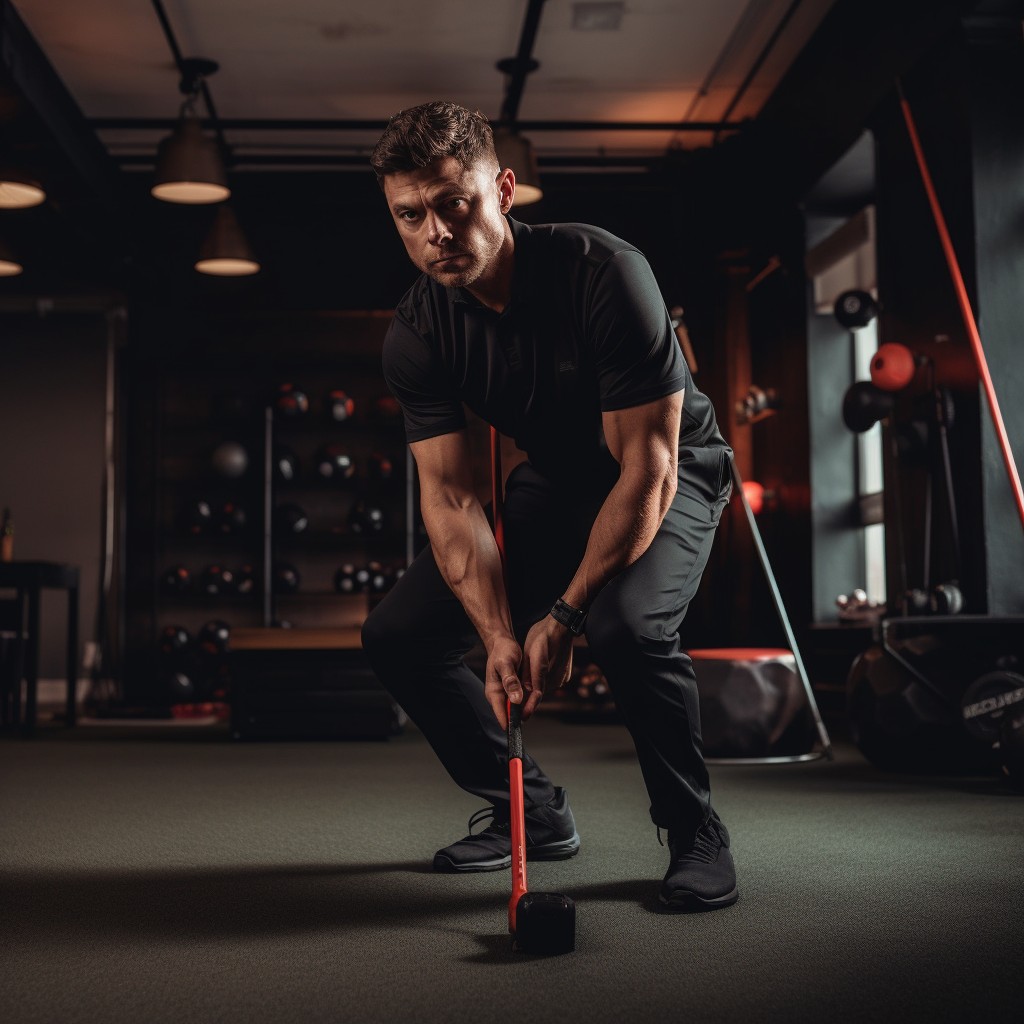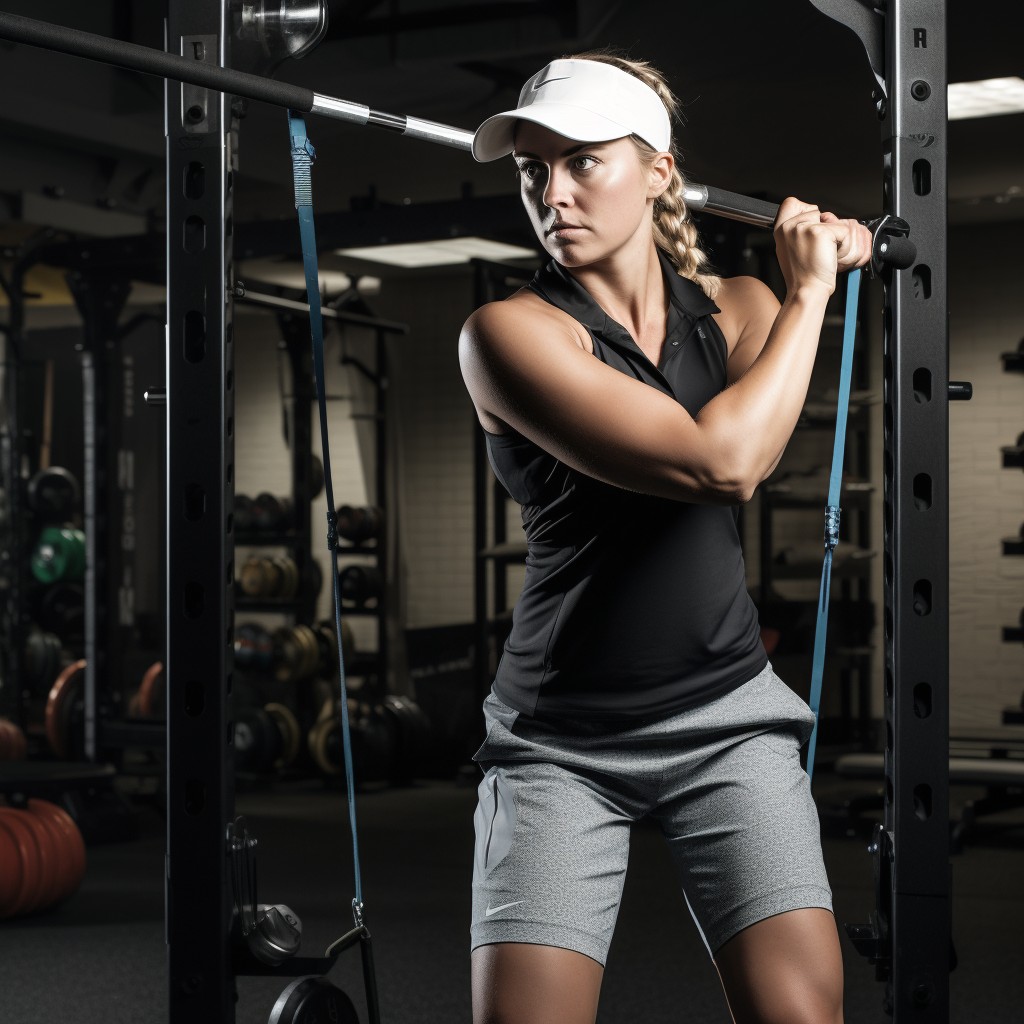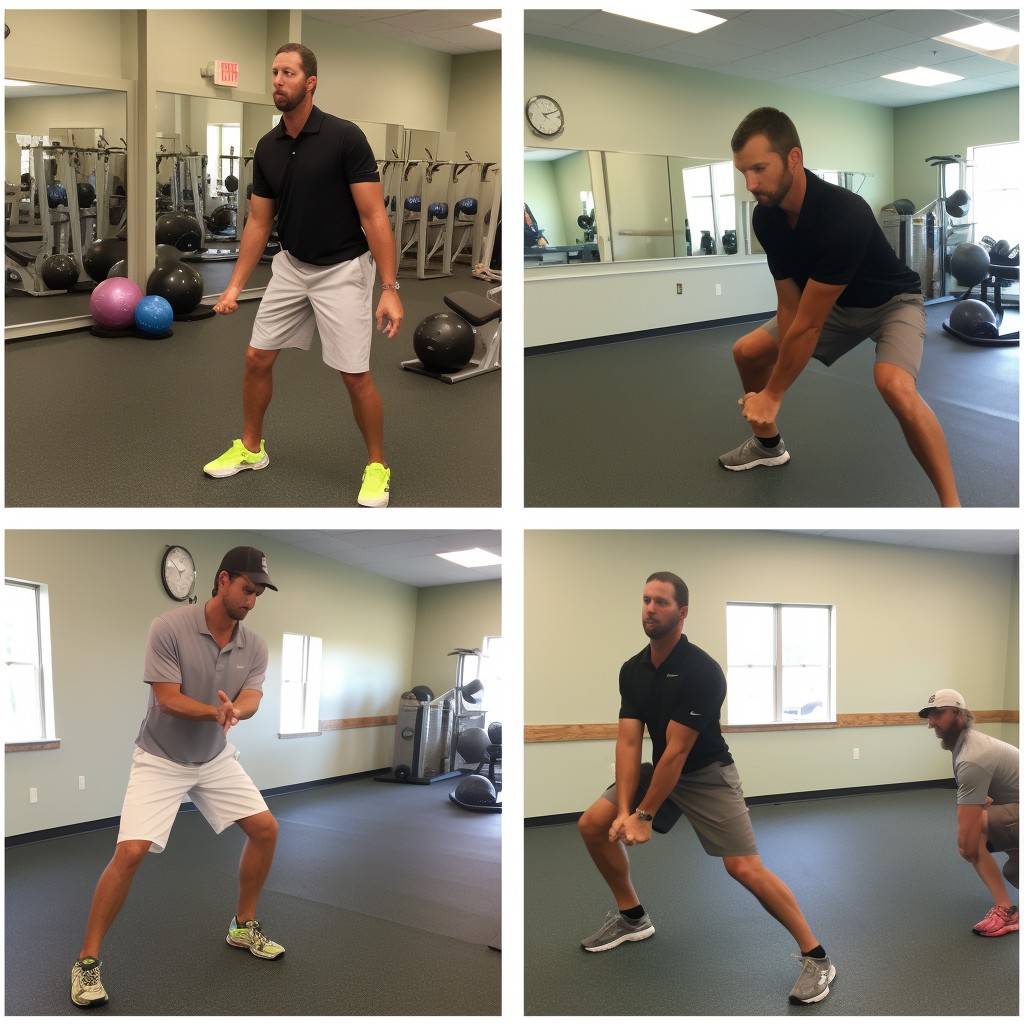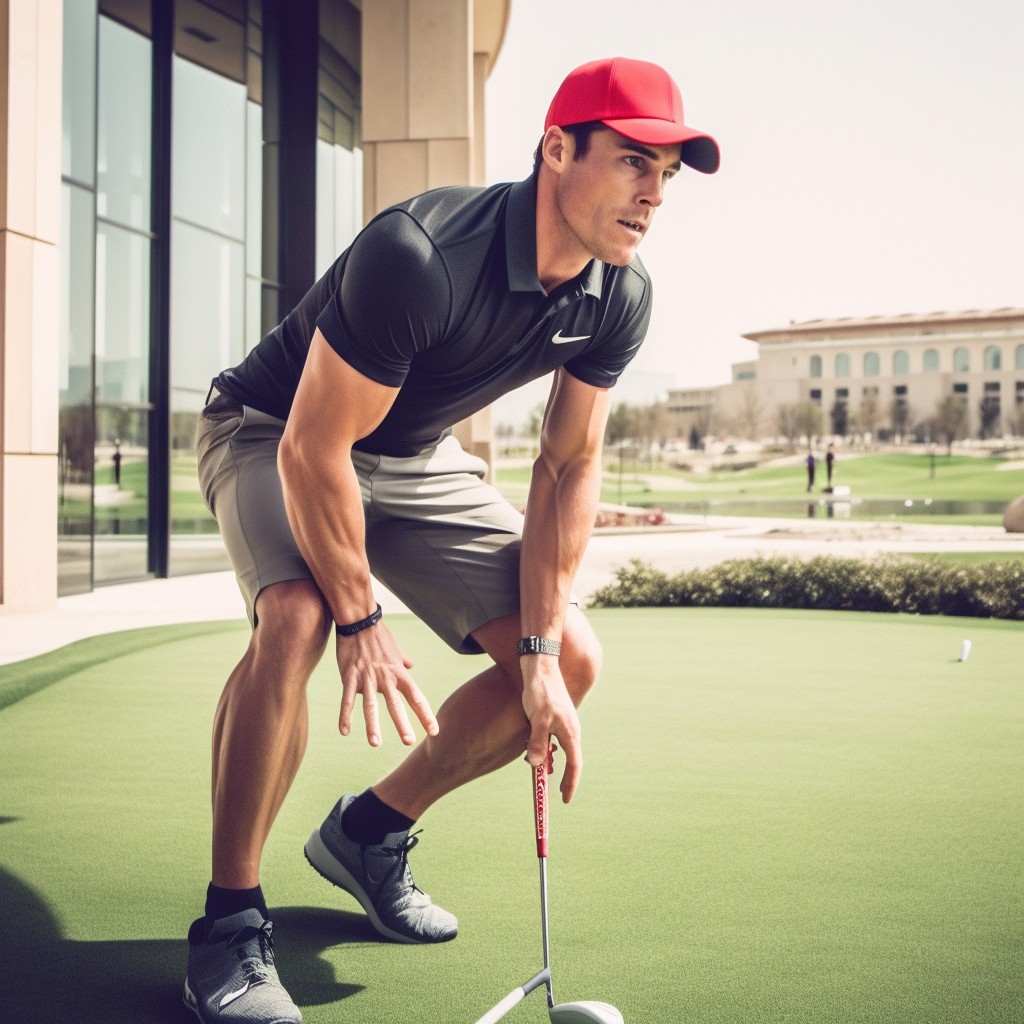
Are you curious about the fitness secrets that give professional golfers their edge? You’re in the right place. We’ll explore how focusing on fitness can elevate your golf game to new heights.
A. Brief overview of the importance of fitness in golf
Golf might not seem like a physically demanding sport at first glance, but that’s far from the truth. Fitness plays a crucial role in a golfer’s performance. A strong, flexible, and agile body can significantly improve your swing, drive, and overall game.
B. The benefits of learning from professional golfers’ fitness secrets
Pro golfers have spent years refining their fitness routines to optimize their performance. By following their lead and incorporating their fitness secrets, we can unlock our own potential on the course. So, let’s dive into the fitness secrets of pro golfers and discover how to elevate your golf game!

Building a Solid Foundation: Core Strength
A strong core is the key to a powerful golf swing. It helps you maintain stability and generate force during your swing. So, let’s dive into why core strength is essential in golf and how to develop it.
A. Importance of core strength in golf
Your core muscles act as the bridge between your upper and lower body, transferring energy and maintaining balance. A strong core allows you to:
- Generate more power in your swing
- Maintain proper posture
- Improve your balance and stability
- Reduce the risk of injury
B. Exercises to develop a strong core
To build a rock-solid core, you can incorporate these exercises into your workout routine:
- Planks: A classic core exercise, planks target your entire core, from your abs to your lower back. To do a plank, get into a push-up position, but rest on your forearms. Keep your body straight and hold the position for 30-60 seconds.
- Russian Twists: This exercise targets your obliques, which are essential for rotational power in your golf swing. Sit on the floor with your knees bent, feet flat, and lean back slightly. Hold a weight or medicine ball in both hands, and twist your torso to touch the weight to the floor on either side of your hips.
- Pilates: Pilates is a fantastic way to improve core strength and stability. With a focus on controlled movements and proper breathing, Pilates exercises can help you develop a strong, balanced, and flexible core that will translate to better performance on the golf course.

Enhancing Flexibility for a Fluid Swing
A smooth, fluid golf swing relies on good flexibility. Greater flexibility allows for a more extended range of motion, which translates to a more powerful and accurate swing. Let’s explore the importance of flexibility in golf and some exercises to help you loosen up.
A. The role of flexibility in golf
Flexibility plays a vital role in a golfer’s performance, impacting the following aspects:
- Swing mechanics: A flexible body allows for a more efficient and powerful swing.
- Injury prevention: Increased flexibility reduces the risk of muscle strains and joint injuries.
- Recovery: Flexible muscles recover faster, which is crucial for golfers who play regularly.
B. Top flexibility exercises for golfers
To improve your flexibility and boost your golf game, try incorporating these exercises into your routine:
- Yoga: Yoga is a fantastic way to improve flexibility, balance, and mental focus. Poses like the Downward Dog, Triangle Pose, and Seated Forward Bend can help you stretch and loosen up your muscles, preparing you for a better golf game.
- Dynamic stretching: Unlike static stretching, dynamic stretching involves moving through a range of motion to increase flexibility. Leg swings, arm circles, and torso rotations are excellent examples of dynamic stretches that can help you limber up before hitting the course.
- Foam rolling: Foam rolling, also known as self-myofascial release, can help you release muscle tension and increase flexibility. Using a foam roller, apply pressure to tight muscles and roll slowly back and forth. Focus on your calves, hamstrings, glutes, and lower back to keep your body loose and ready for golf.

Boosting Stamina and Endurance
Though golf might not seem like an endurance sport, walking 18 holes and maintaining focus throughout the game requires stamina. Building up your endurance can help you stay energized and mentally sharp on the course. Let’s explore the significance of stamina and some training techniques to help you go the distance.
A. The significance of stamina and endurance in golf
Stamina and endurance are essential for golfers because they:
- Improve mental focus, helping you make better decisions on the course.
- Keep you feeling fresh and energized, even during long rounds.
- Enhance overall physical performance, supporting a consistent golf game.
B. Training techniques for improved endurance
To boost your stamina and endurance, consider adding these training methods to your fitness routine:
- Cardiovascular exercises: Regular cardio workouts, such as jogging, cycling, or swimming, can help build endurance and improve heart health. Aim for at least 30 minutes of moderate-intensity cardio most days of the week.
- High-Intensity Interval Training (HIIT): HIIT involves alternating between short bursts of intense exercise and periods of rest or lower-intensity activity. This type of training can quickly improve your cardiovascular fitness and boost your stamina. Try incorporating HIIT workouts like sprints, burpees, or jump squats into your routine.
- Circuit training: Circuit training combines strength and cardio exercises, which can help you build both muscular and cardiovascular endurance. Set up a series of exercise stations, such as push-ups, lunges, and jumping jacks, and move through them with minimal rest between each station. This type of workout is fun, efficient, and highly effective for boosting endurance.

Functional Strength for Powerful Shots
A golfer’s ability to generate powerful shots depends on functional strength. This type of strength comes from training the muscles to work together efficiently, which is crucial for a strong, stable golf swing. Let’s discuss the importance of functional strength in golf and the exercises that can help you build it.
A. Importance of functional strength in golf
Functional strength is essential in golf because it:
- Increases swing power and distance
- Enhances stability and control during your swing
- Improves overall athletic performance and reduces injury risk
B. Key exercises for building functional strength
To develop functional strength that translates to a powerful golf game, try incorporating these exercises into your workout routine:
- Deadlifts: Deadlifts are a fantastic full-body exercise that targets the muscles in your lower back, glutes, and hamstrings. These muscles are essential for generating power in your golf swing. To perform a deadlift, stand with your feet shoulder-width apart, bend at your hips and knees, and grasp a barbell or dumbbells. Keep your back straight, push through your heels, and lift the weight by straightening your hips and knees.
- Kettlebell swings: Kettlebell swings work the entire posterior chain, which includes the muscles in your back, glutes, and hamstrings. To do a kettlebell swing, stand with your feet shoulder-width apart and hold a kettlebell with both hands. Bend at your hips and knees, swinging the kettlebell between your legs. Then, explosively extend your hips and swing the kettlebell up to shoulder height. This movement helps build explosive power in your golf swing.
- Medicine ball throws: Medicine ball throws are excellent for developing rotational power, which is crucial for a powerful golf swing. Stand with your feet shoulder-width apart and hold a medicine ball at chest height. Rotate your torso to one side and throw the ball against a wall or to a partner. Catch the ball and quickly repeat the movement on the other side. This exercise will help you develop the core strength and rotational power needed for a strong golf game.

Injury Prevention and Recovery
Staying injury-free is essential for a consistent and enjoyable golf game. By taking steps to prevent injuries and focusing on recovery, you can keep your body in top shape and enjoy more time on the course. Let’s discuss common golf-related injuries, tips for prevention, and recovery methods used by pro golfers.
A. Common golf-related injuries and their causes
Golfers can experience various injuries, often resulting from repetitive movements, poor technique, or inadequate conditioning. Some common golf-related injuries include:
- Lower back pain
- Golfer’s elbow
- Rotator cuff injuries
- Wrist and hand injuries
- Knee pain
B. Tips for injury prevention
To reduce your risk of injury on the golf course, consider these prevention strategies:
- Proper warm-up and cool-down routines: Warming up before golf can increase blood flow to your muscles and reduce the risk of injury. Try dynamic stretching and light cardio exercises to prepare your body for the game. Afterward, cool down with gentle static stretching to maintain flexibility and aid recovery.
- Strength and mobility training: Regular strength and mobility exercises can help you maintain proper form, reduce stress on your joints, and decrease your risk of injury. Focus on building core strength, functional strength, and flexibility for a well-rounded fitness routine.
- Paying attention to form and technique: A proper golf swing can significantly reduce the risk of injury. Consider working with a golf pro or coach to analyze and improve your swing mechanics.
C. Recovery methods used by pro golfers
Pro golfers understand the importance of recovery for maintaining peak performance. Some effective recovery methods they use include:
- Massage and foam rolling: Massages and foam rolling can help release muscle tension, increase circulation, and speed up recovery. Regularly incorporate these techniques into your routine to keep your muscles feeling fresh and ready for golf.
- Cryotherapy: Cryotherapy, which involves exposing the body to extremely cold temperatures for a short period, can help reduce inflammation and promote recovery. Many pro golfers use this method to recover quickly from intense workouts or long rounds on the course.
- Sleep and nutrition: Prioritize quality sleep and proper nutrition to support your body’s natural recovery processes. Aim for 7-9 hours of sleep per night and eat a balanced diet rich in protein, healthy fats, and complex carbohydrates to fuel your body for peak performance on the golf course.

Pro Golfers’ Fitness Secrets: Real-Life Examples
Learning from the pros can provide valuable insights into what it takes to achieve peak performance on the golf course. Let’s take a closer look at the fitness routines of some specific pro golfers and the lessons we can learn from them.
A. Spotlight on specific pro golfers and their fitness routines
- Rory McIlroy: This professional golfer is known for his intense workout routine, which includes a mix of strength training, cardio, and flexibility exercises. McIlroy often shares his workouts on social media, inspiring golfers worldwide to prioritize fitness. Key takeaways from his routine include the importance of a well-rounded fitness program and dedication to staying in top shape.
- Tiger Woods: Woods has been a trailblazer in golf fitness, incorporating weight training and other athletic training techniques into his routine. His focus on strength and power has contributed to his legendary long drives and overall success on the course. The key lesson from Woods’ approach is the value of functional strength for a powerful golf game.
- Lexi Thompson: As one of the fittest golfers on the LPGA Tour, Thompson’s fitness routine includes a mix of cardio, strength training, and flexibility exercises. Her commitment to fitness not only contributes to her powerful drives but also helps her maintain focus and stamina during long rounds. Thompson’s routine demonstrates the importance of balance in a golfer’s fitness program.
B. Lessons learned from these pro golfers
By examining the fitness routines of these successful pro golfers, we can draw several key lessons for our own golf game:
- Dedicate time to a well-rounded fitness program that includes strength, cardio, and flexibility exercises.
- Prioritize functional strength training to develop power and stability in your golf swing.
- Focus on injury prevention and recovery to stay healthy and consistent on the course.
- Stay committed to your fitness goals and continuously strive for improvement.
By incorporating these lessons into our own fitness routines, we can unlock our potential and elevate our golf game to new heights.

Putting It All Together: Creating Your Ultimate Golf Fitness Routine
Now that we’ve explored the fitness secrets of pro golfers, it’s time to create your own golf fitness routine. By combining the elements we’ve discussed, you can build a well-rounded program that will help you unlock your potential and elevate your golf game.
A. Assessing your current fitness level and setting goals
Before diving into a new fitness routine, it’s essential to assess your current fitness level and set realistic, achievable goals. Consider consulting with a fitness professional, such as a personal trainer or golf fitness expert, to help you determine your strengths and weaknesses and create a plan tailored to your needs.
B. Developing your personalized golf fitness routine
With your goals in mind, create a comprehensive golf fitness routine that includes the following elements:
- Core strength exercises: Incorporate exercises like planks, Russian twists, and Pilates into your routine to build a strong, stable core that will improve your swing and overall performance.
- Flexibility exercises: Include yoga, dynamic stretching, and foam rolling to improve your range of motion, reduce the risk of injury, and enhance your swing mechanics.
- Endurance training: Add cardiovascular exercises, HIIT, and circuit training to your routine to build stamina and mental focus, keeping you energized and sharp on the course.
- Functional strength training: Incorporate exercises like deadlifts, kettlebell swings, and medicine ball throws to develop the power and stability needed for a strong golf game.
- Injury prevention and recovery: Prioritize proper warm-ups and cool-downs, focus on good form and technique, and incorporate recovery methods like massage, cryotherapy, and proper sleep and nutrition to stay healthy and consistent on the course.
C. Staying motivated and tracking progress
Consistency is key to achieving success in your golf fitness journey. Stay motivated by setting short-term and long-term goals, tracking your progress, and celebrating your achievements. Consider joining a golf fitness group or working with a training partner to keep you accountable and make the process more enjoyable.
By putting these elements together and committing to your golf fitness routine, you’ll be on your way to unlocking your full potential and enjoying a better golf game. Happy swinging!

Conclusion: Unleashing Your Inner Golf Pro
To truly elevate your golf game and play like the pros, it’s essential to prioritize fitness and focus on developing a well-rounded routine. By incorporating core strength exercises, flexibility training, endurance workouts, functional strength training, and injury prevention and recovery techniques, you’ll be well on your way to unlocking your full potential on the golf course.
Remember, the journey to becoming a better golfer takes time, dedication, and consistency. Stay motivated by setting achievable goals, tracking your progress, and celebrating your successes along the way. Embrace the lessons we can learn from pro golfers’ fitness secrets and apply them to your own routine. Soon, you’ll not only see improvements in your swing, distance, and accuracy but also in your overall enjoyment of the game.
So, fellow golf enthusiast, it’s time to hit the gym, stretch those muscles, and commit to your golf fitness journey. With hard work, perseverance, and the right approach, you’ll be well on your way to unleashing your inner golf pro and achieving new heights in your golf game. Let’s get swinging!

Frequently Asked Questions
Q1: How often should I work out to improve my golf game?
A1: It’s recommended to engage in some form of physical activity most days of the week. For golf-specific fitness, aim to include a mix of core strength exercises, flexibility training, endurance workouts, and functional strength training in your routine. A good starting point could be 3-4 days of strength training and 2-3 days of cardio, with flexibility exercises incorporated daily.
Q2: What type of cardio is best for golfers?
A2: The best type of cardio for golfers is one that you enjoy and can consistently perform. Running, cycling, swimming, or even brisk walking can all be beneficial for building stamina and endurance. High-Intensity Interval Training (HIIT) and circuit training can also be excellent options for improving cardiovascular fitness in a shorter amount of time.
Q3: Can I improve my golf game without going to the gym?
A3: While going to the gym can provide access to a variety of equipment and training tools, you can still improve your golf game by working out at home or outdoors. Many bodyweight exercises, like push-ups, squats, and lunges, can be done without any equipment. Additionally, you can invest in resistance bands, kettlebells, or dumbbells for added variety and challenge.
Q4: How long does it take to see improvements in my golf game after starting a fitness routine?
A4: The time it takes to see improvements in your golf game after starting a fitness routine can vary depending on factors like your current fitness level, workout consistency, and the type of exercises you’re performing. Generally, you may begin to notice improvements in your strength, flexibility, and endurance within a few weeks of consistent training. However, remember that progress takes time and patience, so stay committed to your routine and celebrate your achievements along the way.
Q5: Are there specific exercises to improve my golf swing?
A5: Yes, there are specific exercises that can help improve your golf swing. Focus on developing core strength, functional strength, and flexibility to enhance your swing mechanics. Some examples of golf-specific exercises include deadlifts, kettlebell swings, medicine ball throws, and yoga poses like the Downward Dog and Triangle Pose. Remember that proper form and technique are also crucial for a better golf swing, so consider working with a golf pro or coach to analyze and improve your swing mechanics.
We want to hear from you! Let us know your comments below.

ABOUT THE AUTHOR
Jim has been an avid golfer and golf fan for over 40 years. He started a YouTube channel called Golf Plus about a year ago and it has been wildly successful. It only made sense to expand and reach more golfers with this site and social media. You can learn more about Jim and Golf Plus Media Group by visiting our About Page.






